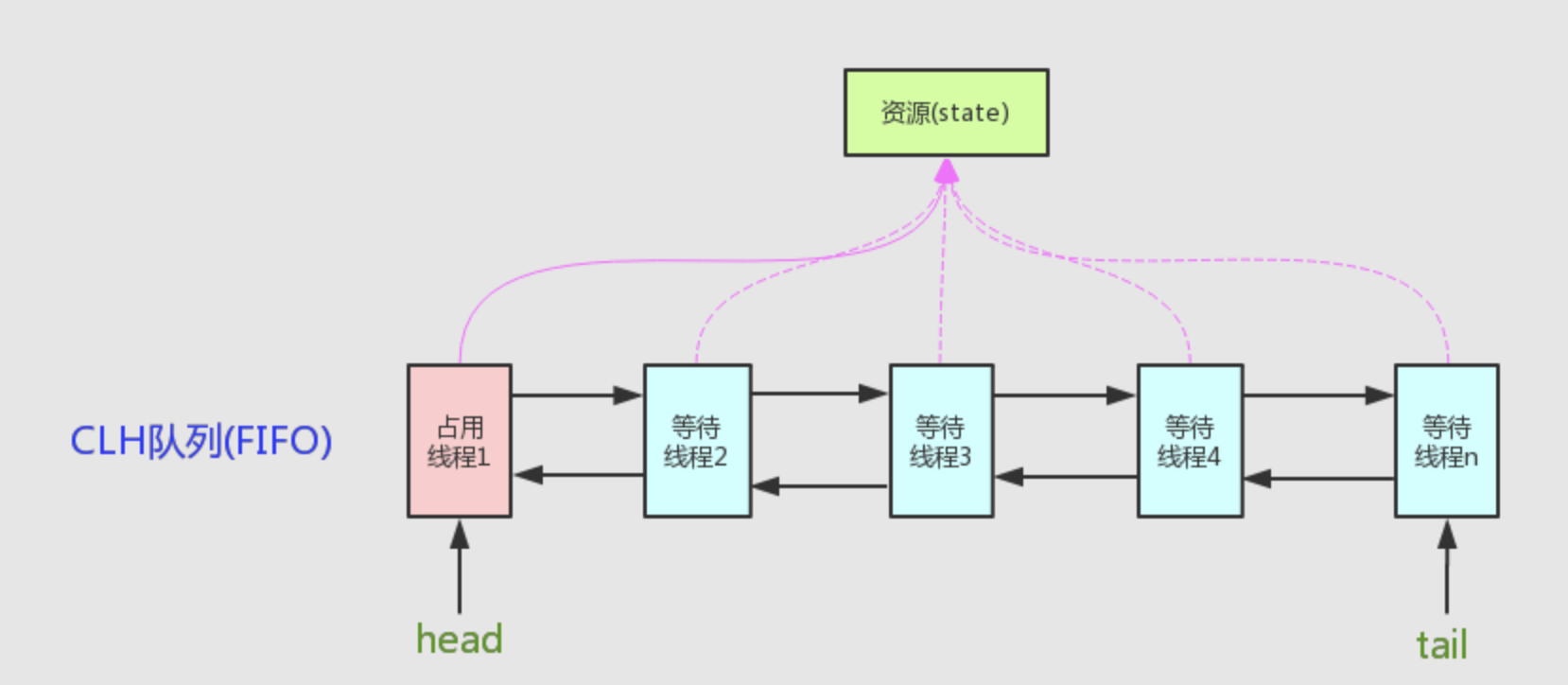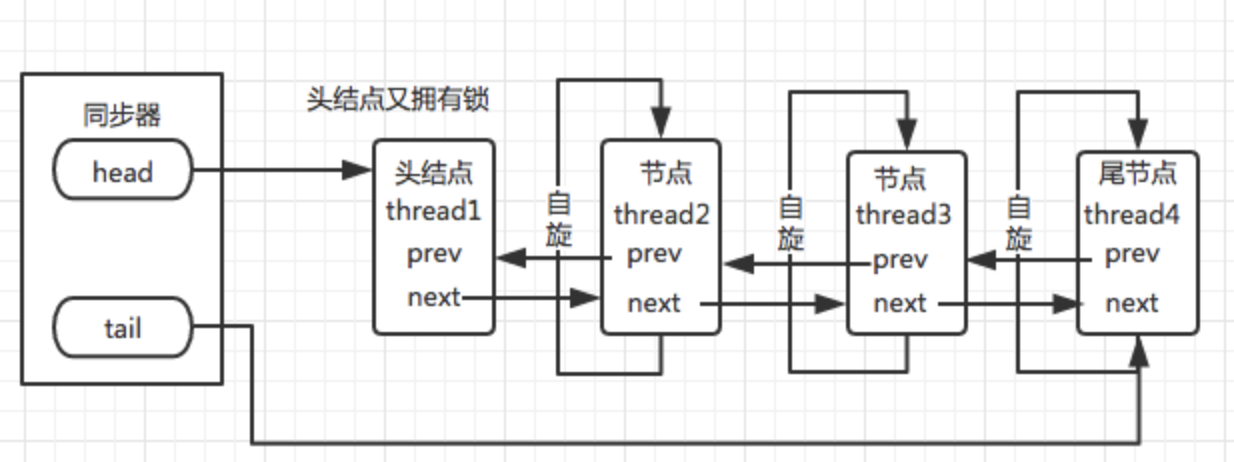一、AQS 是什么?
AQS 是一个基于先进先出(FIFO)等待队列的实现阻塞锁和同步器的框架。AQS 通过一个 volatile int state 变量来保存锁的状态。子类必须通过:
getState():获取当前的同步状态
setState(int newState):设置当前同步状态
compareAndSetState(int expect,int update):使用 CAS 设置当前状态,该方法能够保证状态设置的原子性。
三个方法修改获取锁的状态值 state。
CAS (compare and swap) 比较并交换,就是将内存值与预期值进行比较,如果相等才将新值替换到内存中,并返回 true 表示操作成功;如果不相等,则直接返回 false 表示操作失败。CAS 操作大多都是靠 CPU 原语来实现。CAS 操作经常被用来实现无锁数据结构,在 java.util.concurrent 包中就有很多这样的数据结构:ConcurrentLinkedQueue、ConcurrentLinedDeque、ConcurrentHashMap、ConcurrentSkipListMap、ConcurrentSkipListSet。
1、AQS 支持的锁的类别 AQS 支持独占锁和共享锁两种。
独占锁:锁在一个时间点只能被一个线程占有。根据锁的获取机制,又分为“公平锁”和“非公平锁”。等待队列中按照 FIFO 的原则获取锁,等待时间越长的线程越先获取到锁,这就是公平的获取锁,即公平锁。而非公平锁,线程获取的锁的时候,无视等待队列直接获取锁。ReentrantLock 和 ReentrantReadWriteLock.Writelock 是独占锁。
共享锁:同一个时候能够被多个线程获取的锁,能被共享的锁。JUC 包中 ReentrantReadWriteLock.ReadLock,CyclicBarrier,CountDownLatch 和 Semaphore 都是共享锁。
2、基于 AQS 实现锁 AQS 中没有实现任何的同步接口,所以一般子类通过继承 AQS 以内部类的形式实现锁机制。一般通过继承 AQS 类实现同步器,通过 getState、setState、compareAndSetState 来监测状态,并重写以下方法:
tryAcquire():独占方式。尝试获取资源,成功则返回 true,失败则返回 false。
tryRelease():独占方式。尝试释放资源,成功则返回 true,失败则返回 false。
tryAcquireShared():共享方式。尝试获取资源。负数表示失败;0 表示成功,但没有剩余可用资源;正数表示成功,且有剩余资源。
tryReleaseShared():共享方式。尝试释放资源,如果释放后允许唤醒后续等待结点返回 true,否则返回 false。
isHeldExclusively():该线程是否正在独占资源。只有用到 condition 才需要去实现它。
一般来说,自定义同步器要么是独占方法,要么是共享方式,他们也只需实现 tryAcquire-tryRelease、tryAcquireShared-tryReleaseShared 中的一种即可。但 AQS 也支持自定义同步器同时实现独占和共享两种方式,如 ReentrantReadWriteLock。
二、AQS 源码解析
1、存储节点 Node 我们一直在说 AQS 是基于 FIFO 队列的存储结构,它是以内部类 Node 节点的形式进行存储。这个等待队列是 CLH 同步队列。
static final class Node { /** 共享节点模式下的节点 */ static final Node SHARED = new Node(); /** 独占模式下的节点 */ static final Node EXCLUSIVE = null;
/** 取消状态 */ static final int CANCELLED = 1; /** 后继节点的线程处于等待状态,而当前节点的线程如果释放了同步状态或者被取消,将会通知后继节点,使后继节点的线程得以运行 */ static final int SIGNAL = -1; /** waitStatus value to indicate thread is waiting on condition */ static final int CONDITION = -2; /** * 下一次共享式同步状态获取将会无条件地传播下去 */ static final int PROPAGATE = -3;
/** * Status field, taking on only the values: * SIGNAL: The successor of this node is (or will soon be) * blocked (via park), so the current node must * unpark its successor when it releases or * cancels. To avoid races, acquire methods must * first indicate they need a signal, * then retry the atomic acquire, and then, * on failure, block. * CANCELLED: This node is cancelled due to timeout or interrupt. * Nodes never leave this state. In particular, * a thread with cancelled node never again blocks. * CONDITION: This node is currently on a condition queue. * It will not be used as a sync queue node * until transferred, at which time the status * will be set to 0. (Use of this value here has * nothing to do with the other uses of the * field, but simplifies mechanics.) * PROPAGATE: A releaseShared should be propagated to other * nodes. This is set (for head node only) in * doReleaseShared to ensure propagation * continues, even if other operations have * since intervened. * 0: None of the above * * The values are arranged numerically to simplify use. * Non-negative values mean that a node doesn't need to * signal. So, most code doesn't need to check for particular * values, just for sign. * * The field is initialized to 0 for normal sync nodes, and * CONDITION for condition nodes. It is modified using CAS * (or when possible, unconditional volatile writes). */ volatile int waitStatus;
/** * 前驱节点 */ volatile Node prev;
/** * 后驱节点 */ volatile Node next;
/** * 获取同步状态的线程 */ volatile Thread thread;
/** * Link to next node waiting on condition, or the special * value SHARED. Because condition queues are accessed only * when holding in exclusive mode, we just need a simple * linked queue to hold nodes while they are waiting on * conditions. They are then transferred to the queue to * re-acquire. And because conditions can only be exclusive, * we save a field by using special value to indicate shared * mode. */ Node nextWaiter;
/** * Returns true if node is waiting in shared mode. */ final boolean isShared() { return nextWaiter == SHARED; }
/** * Returns previous node, or throws NullPointerException if null. * Use when predecessor cannot be null. The null check could * be elided, but is present to help the VM. * * @return the predecessor of this node */ final Node predecessor() throws NullPointerException { Node p = prev; if (p == null) throw new NullPointerException(); else return p; }
Node() { // Used to establish initial head or SHARED marker }
Node(Thread thread, Node mode) { // Used by addWaiter this.nextWaiter = mode; this.thread = thread; }
Node(Thread thread, int waitStatus) { // Used by Condition this.waitStatus = waitStatus; this.thread = thread; }}
复制代码
在 Node 内部类中,声明了 pre、next 节点用于队列的连接,同时保存了 waitStatus 状态。
2、AQS 源码解析在面向对象的世界中,想要了解一个类有什么特点,就要看它的属性。通过查看源码,我们看到 AQS 类包含:
/** * Head of the wait queue, lazily initialized. Except for * initialization, it is modified only via method setHead. Note: * If head exists, its waitStatus is guaranteed not to be * CANCELLED. */private transient volatile Node head;
/** * Tail of the wait queue, lazily initialized. Modified only via * method enq to add new wait node. */private transient volatile Node tail;
/** * The synchronization state. */private volatile int state;
复制代码
前驱头节点-head
后驱尾节点-tail
同步器状态-state
AQS 基于 FIFO 队列,接下来就依照 acquire-release、acquireShared-releaseShared 的次序来分析入队和出队。
1、acquire(int)此方法是独占模式下线程获取共享资源的顶层入口。如果获取到资源成功,线程直接返回,否则进入等待队列,直到获取到资源为止,且整个过程忽略中断的影响。这也正是 lock()的语义,当然不仅仅只限于 lock()。获取到资源后,线程就可以去执行其临界区代码了。下面是 acquire 源码:
public final void acquire(int arg) { if (!tryAcquire(arg) && acquireQueued(addWaiter(Node.EXCLUSIVE), arg)) selfInterrupt();}
复制代码
在 acquire 方法中调用了 tryAcquire()、acquireQueued()、addWaiter()三个方法。
首先通过 tryAcquire 方法尝试申请独占锁。如果获取成功则返回 true,否则返回 false。
protected boolean tryAcquire(int arg) { throw new UnsupportedOperationException();}
复制代码
呦西,源码中直接 throw 一个异常。结合我们前面自定义锁的知识,AQS 只是一个框架,具体资源获取和释放方式交由自定义同步器实现。AQS 这里只定义了一个接口,具体资源的获取交由自定义同步器去实现了(通过 state 的 get/set/CAS)!!!至于能不能重入,能不能加塞,那就看具体的自定义同步器怎么去设计了!!!当然,自定义同步器在进行资源访问时要考虑线程安全的影响。
这里之所以没有定义成 abstract,是因为独占模式下只用实现 tryAcquire-tryRelease,而共享模式下只用实现 tryAcquireShared-tryReleaseShared。如果都定义成 abstract,那么每个模式也要去实现另一模式下的接口。说到底,Doug Lea 还是站在咱们开发者的角度,尽量减少不必要的工作量。
接着就是 addWaiter()方法用于将当前线程添加到等待队列的队尾,并返回当前线程所在的节点。
private Node addWaiter(Node mode) { //以给定的Node节点模式构建当前线程的Node节点,在acquire方法中传入的是EXCLUSIVE独占式节点 Node node = new Node(Thread.currentThread(), mode); // 将尾节点进行保存 Node pred = tail; if (pred != null) {//如果尾节点不为null //将尾节点设置尾新节点的prev节点 node.prev = pred; if (compareAndSetTail(pred, node)) {//通过CAS保证,确保节点能够被线程安全的添加 //将当前界定指向前驱的next节点 pred.next = node; return node; } } //如果尾节点为null,则通过enq进行入队 enq(node); return node;}
//同步器通过死循环的方式来保证节点的正确添加,在“死循环” 中通过CAS将节点设置成为尾节点之后,//当前线程才能从该方法中返回,否则当前线程不断的尝试设置。private Node enq(final Node node) { //CAS"自旋",直到成功加入队尾 for (;;) { //尾节点临时存储 Node t = tail; if (t == null) { // Must initialize //如果tail为null,则将 if (compareAndSetHead(new Node())) tail = head; } else { node.prev = t; if (compareAndSetTail(t, node)) { t.next = node; return t; } } }}
复制代码
在 addWaiter(Node node)方法中,将当前线程节点添加到等待队列中。
acquireQueued 在队列中的线程获取锁
/*** Acquires in exclusive uninterruptible mode for thread already in* queue. Used by condition wait methods as well as acquire.** @param node the node* @param arg the acquire argument* @return {@code true} if interrupted while waiting* * acquireQueued方法当前线程在死循环中获取同步状态,而只有前驱节点是头节点才能尝试获取同步状态(锁)( p == head && tryAcquire(arg))* 原因是:1.头结点是成功获取同步状态(锁)的节点,而头节点的线程释放了同步状态以后,将会唤醒其后继节点,后继节点的线程被唤醒后要检查自己的前驱节点是否为头结点。* 2.维护同步队列的FIFO原则,节点进入同步队列之后,就进入了一个自旋的过程,每个节点(或者说是每个线程)都在自省的观察。* */final boolean acquireQueued(final Node node, int arg) { boolean failed = true; try { boolean interrupted = false; //死循环检查(自旋检查)当前节点的前驱节点是否为头结点,才能获取锁 for (;;) { // 获取节点的前驱节点 final Node p = node.predecessor(); if (p == head && tryAcquire(arg)) {//节点中的线程循环的检查,自己的前驱节点是否为头节点 //将当前节点设置为头结点,移除之前的头节点 setHead(node); p.next = null; // help GC failed = false; return interrupted; } // 否则检查前一个节点的状态,看当前获取锁失败的线程是否要挂起 if (shouldParkAfterFailedAcquire(p, node) && //如果需要挂起,借助JUC包下面的LockSupport类的静态方法park挂起当前线程,直到被唤醒 parkAndCheckInterrupt()) interrupted = true; } } finally { //如果有异常 if (failed) //取消请求,将当前节点从队列中移除 cancelAcquire(node); }}
复制代码
通过 addWaiter 方法添加到等待队列中后,在通过 acquireQueued 方法进行锁的获取
函数流程:
tryAcquire()尝试直接去获取资源,如果成功则直接返回;
addWaiter()将该线程加入等待队列的尾部,并标记为独占模式;
acquireQueued()使线程在等待队列中获取资源,一直获取到资源后才返回。如果在整个等待过程中被中断过,则返回 true,否则返回 false。
如果线程在等待过程中被中断过,它是不响应的。只是获取资源后才再进行自我中断 selfInterrupt(),将中断补上。
独占式锁获取流程调用同步器的 acquire(int arg)方法可以获取同步状态,该方法对中断不敏感,即线程获取同步状态失败后进入同步队列,后续对线程进行中断操作时,线程不会从同步队列中移除。获取流程:
当前线程通过 tryAcquire()方法尝试获取锁,成功则直接返回,失败则进入队列排队等待,通过 CAS 获取同步状态。
如果尝试获取锁失败的话,构造同步节点(独占式的 Node.EXCLUSIVE),通过 addWaiter(Node node,int args)方法,将节点加入到同步队列的队列尾部。
最后调用 acquireQueued(final Node node, int args)方法,使该节点以死循环的方式获取同步状态,如果获取不到,则阻塞节点中的线程。acquireQueued 方法当前线程在死循环中获取同步状态,而只有前驱节点是头节点的时候才能尝试获取锁(同步状态)( p == head && tryAcquire(arg))。
2、release(int):独占锁的释放在 AQS 中通过 release 方法进行锁的释放。
public final boolean release(int arg) { //调用tryRelease方法释放 if (tryRelease(arg)) {//如果释放成功 Node h = head; //如果头节点不为null,并且头结点的waitStatus值不为0,即有状态 if (h != null && h.waitStatus != 0) unparkSuccessor(h); return true; } //没有释放成功返回false return false;}
// tryRelease() 尝试释放当前线程的同步状态(锁)protected final boolean tryRelease(int releases) { //c为释放后的同步状态 int c = getState() - releases; //判断当前释放锁的线程是否为获取到锁(同步状态)的线程,不是抛出异常(非法监视器状态异常) if (Thread.currentThread() != getExclusiveOwnerThread()) throw new IllegalMonitorStateException(); boolean free = false; //如果锁(同步状态)已经被当前线程彻底释放,则设置锁的持有者为null,同步状态(锁)变的可获取 if (c == 0) { free = true; setExclusiveOwnerThread(null); } setState(c); return free; }
private void unparkSuccessor(Node node) { /* * If status is negative (i.e., possibly needing signal) try * to clear in anticipation of signalling. It is OK if this * fails or if status is changed by waiting thread. */ int ws = node.waitStatus; if (ws < 0) compareAndSetWaitStatus(node, ws, 0);
/* * Thread to unpark is held in successor, which is normally * just the next node. But if cancelled or apparently null, * traverse backwards from tail to find the actual * non-cancelled successor. */ Node s = node.next; //从队列尾部开始往前去找最前面的一个waitStatus小于0的节点。 if (s == null || s.waitStatus > 0) { s = null; for (Node t = tail; t != null && t != node; t = t.prev) if (t.waitStatus <= 0) s = t; } //唤醒后继节点对应的线程 if (s != null) LockSupport.unpark(s.thread);}
复制代码
release()是独占模式下线程释放共享资源的顶层入口。它会释放指定量的资源,如果彻底释放了(即 state=0),它会唤醒等待队列里的其他线程来获取资源。
3、acquireShared(int)此方法是共享模式下线程获取共享资源的顶层入口。它会获取指定量的资源,获取成功则直接返回,获取失败则进入等待队列,直到获取到资源为止,整个过程忽略中断。下面是 acquireShared()的源码:
public final void acquireShared(int arg) { if (tryAcquireShared(arg) < 0) doAcquireShared(arg);}
private void doAcquireShared(int arg) { final Node node = addWaiter(Node.SHARED);//加入队列尾部 boolean failed = true;//是否成功标志 try { boolean interrupted = false;//等待过程中是否被中断过的标志 for (;;) { final Node p = node.predecessor();//前驱 if (p == head) {//如果到head的下一个,因为head是拿到资源的线程,此时node被唤醒,很可能是head用完资源来唤醒自己的 int r = tryAcquireShared(arg);//尝试获取资源 if (r >= 0) {//成功 setHeadAndPropagate(node, r);//将head指向自己,还有剩余资源可以再唤醒之后的线程 p.next = null; // help GC if (interrupted)//如果等待过程中被打断过,此时将中断补上。 selfInterrupt(); failed = false; return; } } //判断状态,寻找安全点,进入waiting状态,等着被unpark()或interrupt() if (shouldParkAfterFailedAcquire(p, node) && parkAndCheckInterrupt()) interrupted = true; } } finally { if (failed) cancelAcquire(node); }}
复制代码
这里 tryAcquireShared()依然需要自定义同步器去实现。但是 AQS 已经把其返回值的语义定义好了:负值代表获取失败;0 代表获取成功,但没有剩余资源;正数表示获取成功,还有剩余资源,其他线程还可以去获取。所以这里 acquireShared()的流程就是:
tryAcquireShared()尝试获取资源,成功则直接返回;
失败则通过 doAcquireShared()进入等待队列 park(),直到被 unpark()/interrupt()并成功获取到资源才返回。整个等待过程也是忽略中断的。
doAcquireShared(int)此方法用于将当前线程加入等待队列尾部休息,直到其他线程释放资源唤醒自己,自己成功拿到相应量的资源后才返回。
4、releaseShared()releaseShared()是共享模式下线程释放共享资源的顶层入口。它会释放指定量的资源,如果成功释放且允许唤醒等待线程,它会唤醒等待队列里的其他线程来获取资源。
public final boolean releaseShared(int arg) { if (tryReleaseShared(arg)) {//尝试释放资源 doReleaseShared();//唤醒后继结点 return true; } return false;}
复制代码
此方法的流程也比较简单,一句话:释放掉资源后,唤醒后继。跟独占模式下的 release()相似,但有一点稍微需要注意:独占模式下的 tryRelease()在完全释放掉资源(state=0)后,才会返回 true 去唤醒其他线程,这主要是基于独占下可重入的考量;而共享模式下的 releaseShared()则没有这种要求,共享模式实质就是控制一定量的线程并发执行,那么拥有资源的线程在释放掉部分资源时就可以唤醒后继等待结点。例如,资源总量是 13,A(5)和 B(7)分别获取到资源并发运行,C(4)来时只剩 1 个资源就需要等待。A 在运行过程中释放掉 2 个资源量,然后 tryReleaseShared(2)返回 true 唤醒 C,C 一看只有 3 个仍不够继续等待;随后 B 又释放 2 个,tryReleaseShared(2)返回 true 唤醒 C,C 一看有 5 个够自己用了,然后 C 就可以跟 A 和 B 一起运行。而 ReentrantReadWriteLock 读锁的 tryReleaseShared()只有在完全释放掉资源(state=0)才返回 true,所以自定义同步器可以根据需要决定 tryReleaseShared()的返回值。
总结
本节中针对 AQS 进行了简单的学习,总结中参照了以下文章,推荐大家去阅读下。
JUC 回顾之-AQS 同步器的实现原理:https://www.cnblogs.com/200911/p/60313
50.html
JDK 源码之 AQS 源码剖析:http://www.cnblogs.com/showing/p/6858410.html
Java 并发之 AQS 详解:https://www.cnblogs.com/waterystone/p/4920797.html














评论